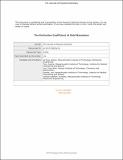Extinction Coefficient of Gold Nanostars
Author(s)
Gehrke, Lee; de Puig Guixe, Helena; Tam, Justina; Yen, Chun-Wan; Hamad-Schifferli, Kimberly
DownloadMain Article (1.777Mb)
PUBLISHER_POLICY
Publisher Policy
Article is made available in accordance with the publisher's policy and may be subject to US copyright law. Please refer to the publisher's site for terms of use.
Terms of use
Metadata
Show full item recordAbstract
Gold nanostars (NStars) are highly attractive for biological applications due to their surface chemistry, facile synthesis, and optical properties. Here, we synthesize NStars in HEPES buffer at different HEPES/Au ratios, producing NStars of different sizes and shapes and therefore varying optical properties. We measure the extinction coefficient of the synthesized NStars at their maximum surface plasmon resonances (SPRs), which range from 5.7 × 10⁸ to 26.8 × 10⁸ M⁻¹ cm⁻¹. Measured values correlate with those obtained from theoretical models of the NStars using the discrete dipole approximation (DDA), which we use to simulate the extinction spectra of the nanostars. Finally, because NStars are typically used in biological applications, we conjugate DNA and antibodies to the NStars and calculate the footprint of the bound biomolecules.
Date issued
2015-07Department
Massachusetts Institute of Technology. Institute for Medical Engineering & Science; Massachusetts Institute of Technology. Department of Mechanical EngineeringJournal
The Journal of Physical Chemistry C
Publisher
American Chemical Society (ACS)
Citation
de Puig, Helena; Tam, Justina O.; Yen, Chun-Wan; Gehrke, Lee and Hamad-Schifferli, Kimberly. "Extinction Coefficient of Gold Nanostars." The Journal of Physical Chemistry C 119, no. 30 (July 2015):17408–17415. © 2015 American Chemical Society
Version: Author's final manuscript
ISSN
1932-7447
1932-7455